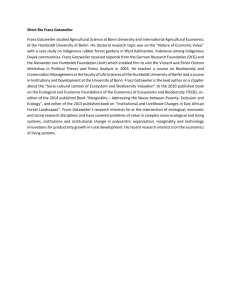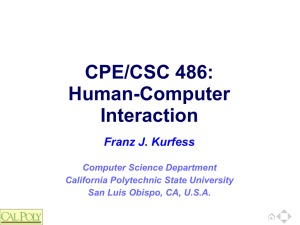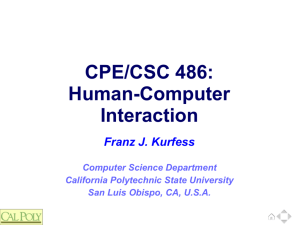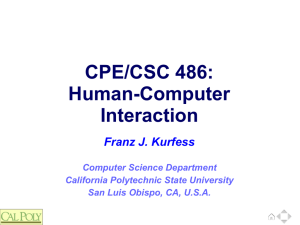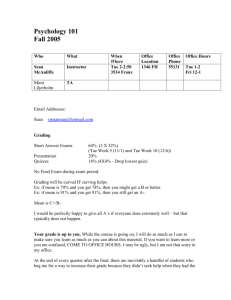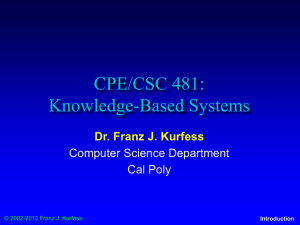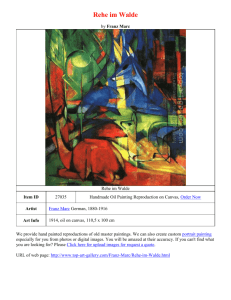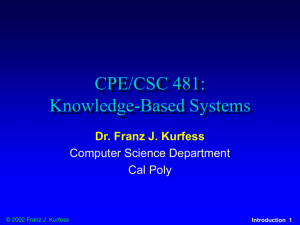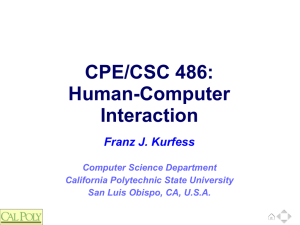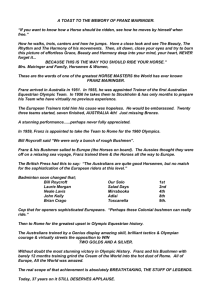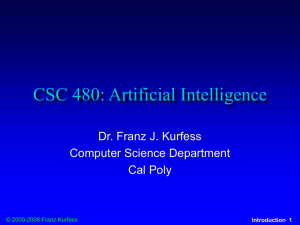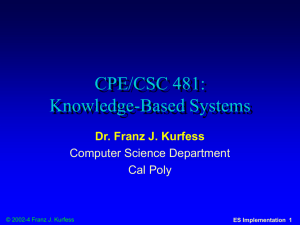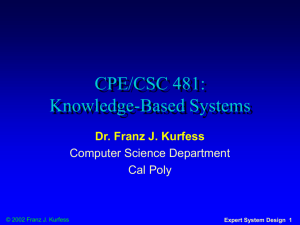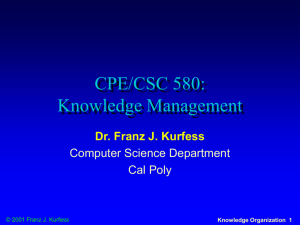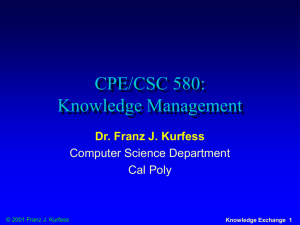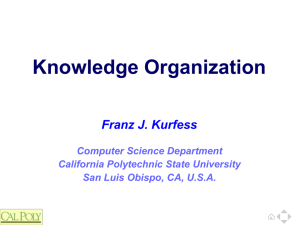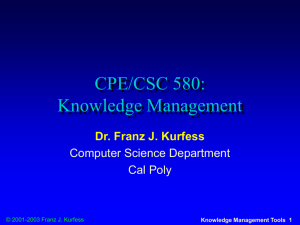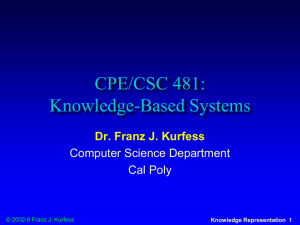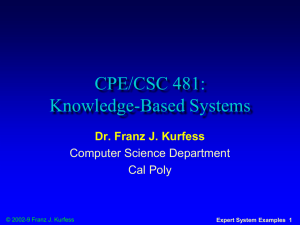Input/Output Devices
advertisement
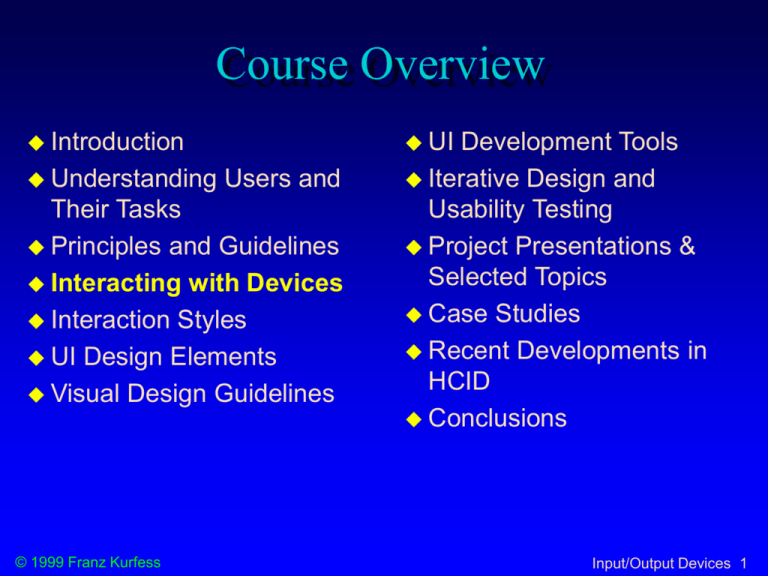
Course Overview Introduction Understanding UI Users and Their Tasks Principles and Guidelines Interacting with Devices Interaction Styles UI Design Elements Visual Design Guidelines © 1999 Franz Kurfess Development Tools Iterative Design and Usability Testing Project Presentations & Selected Topics Case Studies Recent Developments in HCID Conclusions Input/Output Devices 1 Chapter Overview Interacting with Devices Agenda Output Motivation Objectives Input Devices Survey Characteristics Performance Advantages and Problems © 1999 Franz Kurfess Devices Survey Characteristics Performance Advantages and Problems Important Concepts and Terms Chapter Summary Input/Output Devices 2 Information transfer rates Information transfer rates of popular I/O devices output computer screen laser printer loudspeakers input keyboard mouse microphone (speech input) scanner digital camera © 1999 Franz Kurfess Input/Output Devices 5 Motivation the devices used for input and output determine the nature and capacity of information transferred between human and computer characteristics of the I/O devices influence user interface design to a large degree the choice of an inappropriate or inadequate design will diminish the performance of the task combinations of I/O devices can increase the usability of a system © 1999 Franz Kurfess Input/Output Devices 6 Objectives identify the main I/O devices used in computer systems know the important characteristics of these devices evaluate the suitability of I/O devices for particular purposes or tasks be able to select an appropriate combination of I/O devices for a specific task © 1999 Franz Kurfess Input/Output Devices 7 Input and Output Devices I/O devices are hardware elements connect the physical human effectors (hands, vocal cords) to the input channels of computers are the channels through which users and software communicate task demands, such as the need for hands-free or silent operation, affect the choice of input and output devices to use © 1999 Franz Kurfess [Mustillo] Input/Output Devices 9 Controls usually software elements shown on the display used to set preferences and make choices some familiar controls: menus radio buttons,check buttons, toggles, sliders some hardware controls: contrast, brightness, etc. on screens volume on speakers some controls are used for both input and output show users choices or current setting allow users to operate the control example: printer control © 1999 Franz Kurfess [Mustillo] Input/Output Devices 10 Input Devices purpose entering data into a computer system issuing instructions (commands) to a computer input device transforms data from the user into a form that a computer system can process together with appropriate software (device drivers) © 1999 Franz Kurfess [Mustillo] Input/Output Devices 11 Overview Input Devices need to specify the objects and actions of interaction what should be done how can it be done logical equivalence of input devices e.g. mouse and cursor keys can be used for the same input tasks © 1999 Franz Kurfess [Mustillo] Input/Output Devices 12 Categories of Input Devices keys and buttons keyboards most common (QWERTY, Dvorak, chord, alphabetic) keypads (numeric, telephony, calculator) buttons - discrete entry device function keys cursor keys © 1999 Franz Kurfess [Mustillo] Input/Output Devices 13 Keyboards as Input Devices QWERTY keyboard Dvorak keyboard alphabetical keyboard chord keyboard numeric keypad © 1999 Franz Kurfess [Mustillo] Input/Output Devices 17 QWERTY Keyboard uses the most common arrangement of alpha and numerical keys. required when input data are variable many users are trained for using it very slow for untrained users not designed for 10-finger typing keys are distributed strangely left hand has to work harder than the right © 1999 Franz Kurfess [Mustillo] Input/Output Devices 18 Alphabetical Keyboard arrangement of keys in alphabetical order suitable for untrained users slower in than the QWERTY or Dvorak keyboards general, avoid its use for PC applications confusing © 1999 Franz Kurfess for most users [Mustillo] Input/Output Devices 20 Mouse as Input Device How many buttons are optimal? ongoing human factors debate 1 (Apple) easier to double click a single button to select an item than to remember which button points and which extends 2 (Xerox, Microsoft) one to point and the other to extend (special commands) largest population among mouse species 3 (most workstations) more functions directly available confusing at first; gets easier with practice novice or infrequent users often forget which button does what © 1999 Franz Kurfess [Mustillo] Input/Output Devices 29 Selecting Input Devices the input device should match physiological / psychological characteristics of users, their training, and their expertise e.g. older adults may be hampered with arthritis, and may be unable to type; inexperienced users may be unfamiliar with keyboards and keyboard layouts, etc. be e.g. a drawing task requires a device that allows continuous movement; selecting an option from a list requires an input device that permits discrete movement, etc. be appropriate for the tasks to be performed suitable for the intended work and environment e.g. speech input may be useful when there is no keypad or keyboard, or when the eyes and hands are busy, but is unsuitable in noisy conditions; automatic scanning is suitable if there is a large amount of data to be gathered, etc. © 1999 Franz Kurfess [Mustillo] Input/Output Devices 36 Output Devices convert information coming from a computer system into some form perceptible by humans visual auditory (non-speech, speech) tactile tactile output for visually-impaired and blind users (e.g., Braille) © 1999 Franz Kurfess [Mustillo] Input/Output Devices 37 Visual Output Devices character-based liquid-crystal displays [LCDs],flat-panel displays [FPDs] used in stationary devices, in telephones, calculators, etc. graphics displays CRTs, LCDs, and other FPDs, 3D HRES graphic displays used in stationary output devices, cockpits, or helmet-mounted displays printing devices color vs. black and white; dot matrix, laser, inkjet fax plotters (colored pens) microfiche displays or microfilm require special equipment to read videotape © 1999 Franz Kurfess [Mustillo] Input/Output Devices 38 Recent Developments in I/O Devices handwriting 3M smart recognition/personal digital assistants Palm Pilot, Go Corp., Sony, Toshiba card thin plastic card, embedded µprocessor and memory information about a user (e.g., employee ID, credit details, etc.) is stored on the card. outputs information to special card readers. biometric device advanced smart card that contains characteristics about a user such as fingerprints, voice prints, retina prints, or signature dynamics. © 1999 Franz Kurfess [Mustillo] Input/Output Devices 43 Recent Developments (cont.) haptic devices make it possible for users to touch, with their hands and fingers, virtual computer models as if they were real-world physical objects i.e., feel an object’s mass, explore its texture, and work with its form and shape not many on the market; one of the more interesting ones is from a company called “haptic” (www.haptic.com)\ © 1999 Franz Kurfess [Mustillo] Input/Output Devices 44 Recent Developments (cont.) wearable Private computer Eye™ (Reflection Technology) user wears a single high-resolution LCD over one eye, while looking out the other eye; image projected at infinity coupled with a portable computer, and other input devices Wearable Computer™ (Computing Devices International) portable, body-mounted, voice-activated computer recently tested in Bosnia, presently being adopted by the U.S. Armed Services helmet-mounted military © 1999 Franz Kurfess display with speech interface applications, “aim-fire” scenarios [Mustillo] Input/Output Devices 47 Touchy Mouse Logitech’s WingMan Force Feedback mouse www.logitech.com incorporates tactile feedback user can feel the edges, contours, densities of virtual objects can make navigation more intuitive uses a special mousepad with rods connected to tiny motors © 1999 Franz Kurfess Input/Output Devices 48 Current Research Areas texture sensation sandpaper system (MIT) uses a motor-driven, force-feedback joystick that uses tiny virtual springs to simulate motion while the user moves the joystick over patches of computationally created textures displayed on a screen tracking Active Badge™ system (Olivetti/DEC) tracks people inside a building used as a communications device can be turned off for privacy © 1999 Franz Kurfess [Mustillo] Input/Output Devices 50 Current Research Areas (cont.) gesture, speech, and gazing two-handed gesturing by voice, and selection by gaze (CMU) “Turn that block upside down.” © 1999 Franz Kurfess [Mustillo] Input/Output Devices 51 Future Trends smart can rooms identify people and interpret their actions house that knows where your kids are and tells you if they are getting into trouble can supervise students during exams ;-) research being conducted at MIT Person Finder - Pfinder incorporates video cameras for recognizing faces, expressions, gestures microphones for speech recognition smart home performs activities according to user’s preferences and usual actions © 1999 Franz Kurfess [Mustillo] Input/Output Devices 52 Future Trends (cont.) smart sort clothes of a personal assistant that you wear tells you the name of people you meet, directions to your next meeting, etc. built-in computer, camera, microphones, other sensors camera built into the frame of eyeglasses that captures images face-recognition software that tells you the name of the person you are looking at by whispering his or her name into your ear © 1999 Franz Kurfess [Mustillo] Input/Output Devices 53 Important Concepts and Terms auditory input/output button camera controls cursor keys device driver display function keys handwriting recognition human-machine interface icon input devices joystick key keyboard microphone © 1999 Franz Kurfess monitor mouse output devices pointing devices printing devices scanner screen speech recognition speech synthesis sound switch tactile input/output trackball touch screen usability use case scenarios visual input/output Input/Output Devices 56 Additional Reading Gaver, W.W. (1986). Auditory icons: Using sound in computer interfaces. Human-Computer Interaction, 2(2), 167-177. Pentland, A.P. (1996). Smart rooms. Scientific American, 274(4), 68-76. (April issue). © 1999 Franz Kurfess [Mustillo] Input/Output Devices 57 Chapter Summary overview of important devices for input to and output from the computer the characteristics of a device determine its suitability for particular methods and tasks the selection of I/O devices and methods influences the usability of a user interface substantially research in novel I/O devices and methods tries to overcome the limitations of screen and paper as most important output, and keyboard and mouse as input devices © 1999 Franz Kurfess Input/Output Devices 58 © 1999 Franz Kurfess Input/Output Devices 59


